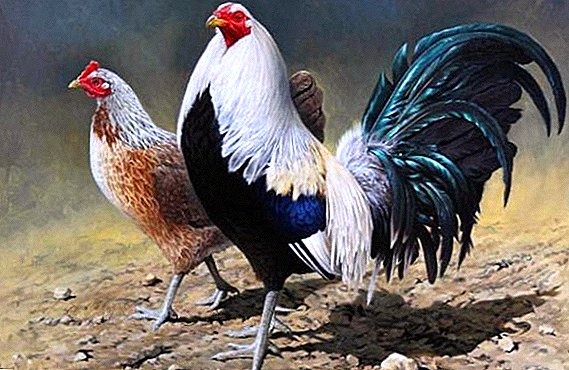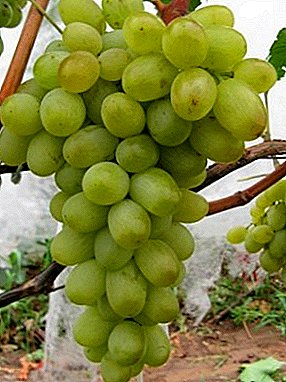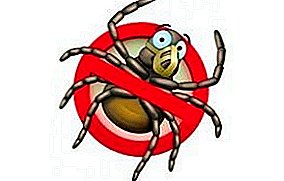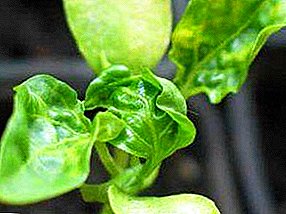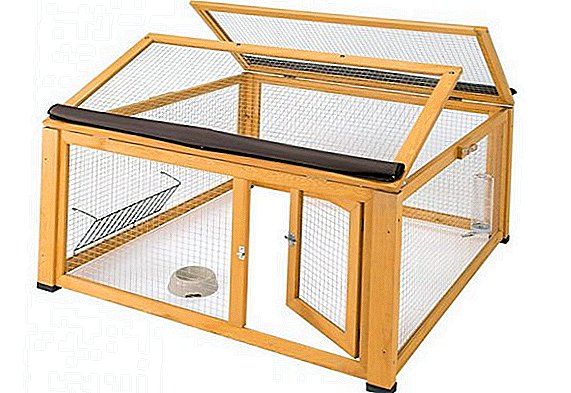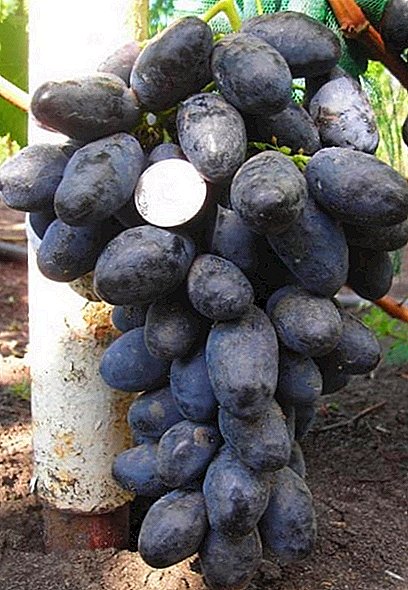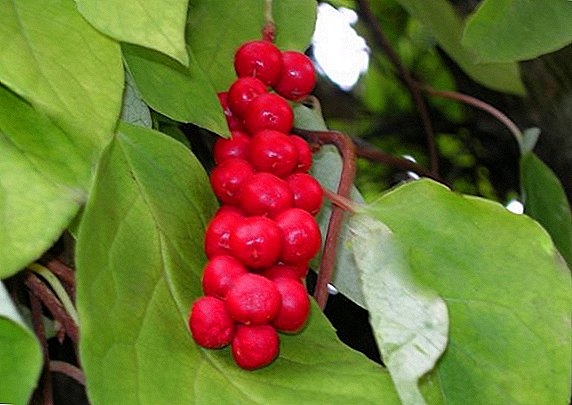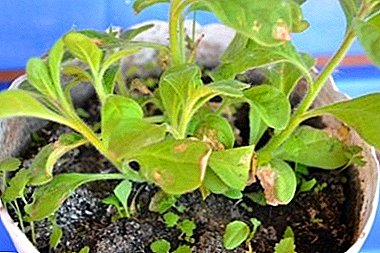
It can not be said that petunia is a very naughty plant. The proof is its widespread distribution. However, lovers of this flower know how to accurately observe the moisture regime or pick up the soil mixture.
The same applies to the pest control of petunia. The invasion of aphids or mites can ruin the efforts of several months of work, but the skillful combination of various means of protection and timely processing are quite capable of dealing with this problem.
Growth features
In cold climates, petunia is sown in the second half of March, in warm months - the first half of March or at the end of February. A temperature of about +25 ° C and a humidity of about 98% is required. Water for seedlings should come from the bottom, from the pan. After the appearance of 2-3 leaves, the plant is transplanted. When there are four leaves on a plant, they pinch it (remove the tip). For planting should choose the sunny side of the room or area.
Exposure to various attacks
Petunia is subject to the same pest attacks as many other flowers and useful crops. It:
- mite;
- aphid;
- springtail;
- whitefly;
- thrips;
- sciarides (mushroom mosquitoes);
- slugs
The first four representatives on this list are worth talking in more detail.
Aphids on the plant: causes of appearance, folk remedies
 A colony of aphids, covered with leaves and stems, is clearly visible.
A colony of aphids, covered with leaves and stems, is clearly visible.
- Frequently, larvae, adults, winged and wingless forms of the insect coexist here.
- Numerous skins discarded by the larvae are visible.
- With the advent of the pest, the plant ceases to grow.
- The leaves are deformed, the already blooming flowers grow dim, and the buds wither and fall.
- The plant affected by aphids is covered with sticky droplets of pest excretions. This leads to the appearance of soot fungus, clearly visible on the extensive black spots.
We must try to attract natural enemies of aphids to the site.. It:
- gold-eyed (flornitsa);
- usual seven-point ladybug;
- hoverflies and others.
These natural assistants help the grower to contain the growth of many thousands of aphid colonies without regular spraying with chemicals.
Folk remedies:
- Remove by hand, shake, churn insects with a stream of water.
- Spray with a solution of soap, household or tar.
- Add baking soda to liquid soap (1 tablespoon soda per 1 liter of water).
- The same, but instead of soda, take a mixture of hot-smelling spices: pepper, mustard, and cinnamon.
- 5 g of liquid ammonia or 100 ml of table vinegar diluted in 1 liter of cold water.
- Add wood ash to the soil.
- Mix the ash with soapy water.
- Wormwood, celandine, tops of tomatoes (or tansy) and potatoes pour five liters of water. Let it brew for 3 days. Then boil for an hour and add soap.
You can also use boric acid, ammonia, milk, in which a few drops of iodine are added. The flowers are sprayed, starting in spring, when the aphid that has appeared is unusually active. First, they maintain an interval of 5-10 days, and then - once a month.
“Heavy” chemistry should be transferred only if the threat of the spread of aphids is really great. It should be borne in mind that, along with pests, beneficial insects are also affected.
Among the time-tested can be called "Aktar", (as well as a number of other brands that use thiamethoxam as an active substance). The insecticide is introduced under the root, from where it rises to the very top of the plant. Now the flower is reliably protected for 40-50 days.

How to deal with spider mite?
Spider mite lives in the soil and on the lower leaves. Settles large enough groups. Coloring may be different:
- brown
- yellow;
- green
Tiny pest is not easy to consider, more often we pay attention to the small cobwebs that it leaves. Tick eggs remain viable for up to five years. Spider mites easily move from one plant to another. Piercing the surface of the leaf, they feed on its juices.
Spider mite is unusually resistant to "chemistry", so that the fight against it turns into a difficult task.
- It is necessary to isolate infected petunia from healthy plants.
- Prepare a solution of dishwashing detergent (or just soap).
- Plants, especially the reverse side of the leaves, moistened entirely.
- It should wash the pot, window sill.
- The mite does not tolerate moisture, so after processing, you need to pour a flower abundantly and cover with a plastic bag.
This method will at least help reduce the number of colonies.
Some more popular methods of struggle:
- Garlic garlic infused for 24 hours. Take 170 g of pulp in 1 liter of water.
- Infuse 2 hours dandelion. Take 30 g of dandelion 1 liter of water.
- In special cases (for example, the neighborhood with fruit crops), you can use biological products, in particular, "Fitoverm" (analogue - "Kleschevit").
- Relatively new drug "Sunmite" will easily destroy the tick at any stage of development. To clear the petunia from pests, one hour is enough. Re-processing - in 30-40 days.

What to do if white flies appear?
Sometimes on a petunia (and not only on it) you can see whitish insects with a size of 1 mm. They hide from the back of the sheet or jump on the ground. This is a white podura, representative of springtails, which in nature comprise thousands of species. They lay eggs at a depth of about 3 cm.
The parasite does little harm to the flower, but when the organic in the pot ends, it can seriously take up roots and shoots. Gradually, the petunia begins to hurt and weaken. The ideal medium for a white suture is a waterlogged soil in which the processes of decay begin.
Methods of struggle:
- After restoring a rational irrigation regime, you can pour a layer of sand (small gravel) into the pot as an upper drainage.
- A more radical method is to remove 4-5 centimeters of soil, with eggs and larvae of the pest, and replace it with a new one.
- You can collect and destroy a large number of pests, putting half the potatoes in the pot, cut down.
- Alternatively, the soil is sprinkled with ashes or disinfected with a solution of potassium permanganate (not darker than pink!).
- From the "improvised means" can be useful conventional fumigators (mosquito repellent), with plates or liquid.
- It is hardly necessary to present aerosols - Raptor, Reid, traditional Dichlorvos and Dichlorvos-neo. The soil is loosened, they create a "cocoon" of film, spray a toxic substance near the ground and cover it with a film for several hours.

How to deal with the whitefly?
Whiteflies are dangerous pests of petunias. In this respect, they are not inferior to mites or ats.
These are butterflies no larger than 1.8 mm in size, with wings as if covered with flour. Coming out of the egg, the larva feeds on the sap of the plant, covering it with a special wax coating. Having lost nutrients, the leaves turn yellow, curl and dry.
Notable symptoms are mosaic coloring and leaf deformation.. The growth of young shoots, as a rule, slows down. As in aphids, whitefly excretions become a breeding ground for the black fungus, and the black spots that form here cause permanent damage to the appearance of the flower.
In addition to the golden-eyed and ladybugs, these are pupae of the parasite enkarzii and the predatory bug makrolofus. A certain effect can be given by spraying with garlic or tobacco infusion, placing glue traps near the flowers.
Some of the reliable tools:
- Aktara;
- "Confidor", (as well as analogues based on imidaclopridom);
- "Akarin" (another name "Agravertin");
- "Spark" (in any modification);
- "Actellic" (in view of toxicity - only for street landings).

Preventive measures
A barrier in the path of pests can be put in the most ordinary ways, if only to apply them always and on time:
- soil treatment (thermal or chemical);
- purchase of high-quality substrate;
- airing (against black flies);
- drainage, loosening (against blackflies);
- strictly dosed irrigation mode;
- the destruction of anthills (against aphids);
- destruction of infected leaves in the fall;
- regular inspection of plants;
- "quarantine" for plants brought from the street or bought on the market.
With the observance of the norms of prevention, proper watering and successful combination of folk and chemical remedies, it is possible to reduce the number of insects that threaten the health of petunias to a minimum.


